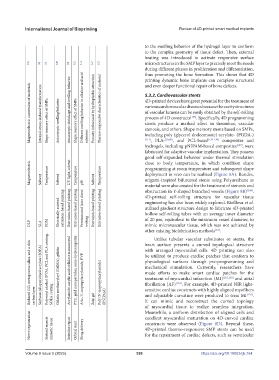Page 334 - IJB-9-5
P. 334
International Journal of Bioprinting Review of 4D-printed smart medical implants
to the swelling behavior of the hydrogel layer to conform
to the complex geometry of tissue defect. Then, external
heating was introduced to activate responsive surface
[152] [33] [31] [149] [85] [153] [114] [157] [155] microstructures in the SMP layer to precisely meet the needs
during different phases in proliferation and differentiation,
thus promoting the bone formation. This shows that 4D
printing dynamic bone implants can complete structural
Magnetoelectric conversion of materials Internal-stress-induced transformation Shape memory effect of SMPs Anisotropic swelling behavior Anisotropic shrinkage and swelling behavior Shape memory effect of SMPs Different swelling behavior in alkaline and acid Porosity influenced by hydrophobic attraction Thermo-responsive characteristics of material 5.3.2. Cardiovascular stents
and even deeper functional repair of bone defects.
4D-printed devices have great potential for the treatment of
various cardiovascular diseases because the cavity structures
of vascular lumens can be easily obtained by the self-rolling
. Specifically, 4D programming
process of 4D constructs
[133]
stents produce a marked effect in thrombus, vascular
stenosis, and others. Shape memory stents based on SMPs,
solutions
including poly (glycerol dodecanoate) acrylate- (PGDA-)
, PLA-
composites and
, and PCL-based
[111]
[134-136]
[30,60]
hydrogels, including pNIPAM-based composites [137] , were
fabricated for adaptive vascular implantation. They possess
good self-expanded behavior under thermal stimulation
close to body temperature, in which condition shape
Magnetoelectric Solvent Temperature Solvent UV light, solvent Temperature pH Solvent Temperature programming at room temperature and subsequent shape
deployment in vivo can be realized (Figure 8A). Besides,
origami-inspired bifurcated stents using Polyurethane as
material were also created for the treatment of stenosis and
obstruction in Y-shaped branched vessels (Figure 8B)
.
[104]
Electrically assisted extrusion-based printing Extrusion-based printing Extrusion-based printing Femtosecond laser direct Extrusion-based printing Extrusion-based printing 4D-printed self-rolling structure for vascular tissue
engineering has also been widely explored. Kirillova et al.
utilized gradient structure design to fabricate 4D-printed
hollow self-rolling tubes with an average inner diameter
DLP SLA FDM writing of 20 μm, equivalent to the minimum vessel diameter, to
mimic microvascular tissue, which was not achieved by
other existing biofabrication methods .
[12]
Unlike tubular vascular substitutes or stents, the
Reduced GO, mesoporous silica, and a thin Soybean oil epoxidized acrylate (SOEA) Polyvinyl alcohol (PVA), PCL and PLA coating, Gelatin methacryloyl (GelMA), gelatin Acrylamide-acrylic acid/cellulose nanocrystal PTU, gold nanoparticles, nano-hydroxyapatite AAc, N-isopropylacrylamide, PVP Poly (N-isopropylacrylamide) be utilized to produce cardiac patches that conform to
heart surface presents a curved topological structure
with arranged myocardial cells. 4D printing can also
physiological surfaces through pre-programming and
mechanical stimulation. Currently, researchers have
made efforts to make smart cardiac patches for the
and atrial
treatment of myocardial infarction (MI)
[110,138]
. For example, 4D-printed NIR light-
fibrillation (AF)
[139]
SOEA coating
sensitive cardiac constructs with highly aligned myofibers
carbon layer
(PNIPAM)
.
and adjustable curvature were produced to treat MI
Zein gel
[110]
It can mimic and reconstruct the curved topology
of myocardial tissue to realize seamless integration.
Meanwhile, a uniform distribution of aligned cells and
Nerve regeneration Skeletal muscle mimetic tissue Intestine repair Orbital stent Drug delivery excellent myocardial maturation on 4D-curved cardiac
constructs were observed (Figure 8D). Beyond these,
4D-printed thermo-responsive SMP stents can be used
for the repairment of cardiac defects, such as ventricular
Volume 9 Issue 5 (2023) 326 https://doi.org/10.18063/ijb.764

